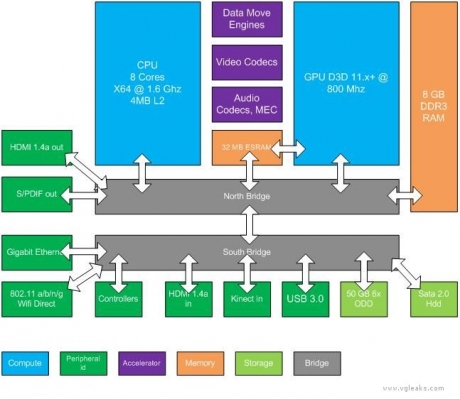As we promised during the weekend in the next weeks we will unveil Durango and Orbis. All the technical info you want to know about the next generation machines from Sony and Microsoft.
The first one is Durango. In this article we present the system overview with the general components and some technical details about them.
How are durango components connected?
Above you can see the Durango system block diagram.
Let’s check what’s inside the box:
CPU:
- x64 Architecture
- 8 CPU cores running at 1.6 gigahertz (GHz)
- each CPU thread has its own 32 KB L1 instruction cache and 32 KB L1 data cache
- each module of four CPU cores has a 2 MB L2 cache resulting in a total of 4 MB of L2 cache
- each core has one fully independent hardware thread with no shared execution resources
- each hardware thread can issue two instructions per clock
GPU:
- custom D3D11.1 class 800-MHz graphics processor
- 12 shader cores providing a total of 768 threads
- each thread can perform one scalar multiplication and addition operation (MADD) per clock cycle
- at peak performance, the GPU can effectively issue 1.2 trillion floating-point operations per second
High-fidelity Natural User Interface (NUI) sensor is always present
Storage and Memory:
- 8 gigabyte (GB) of RAM DDR3 (68 GB/s)
- 32 MB of fast embedded SRAM (ESRAM) (102 GB/s)
- from the GPU’s perspective the bandwidths of system memory and ESRAM are parallel providing combined peak bandwidth of 170 GB/sec.
- Hard drive is always present
- 50 GB 6x Blu-ray Disc drive
Networking:
- Gigabit Ethernet
- Wi-Fi and Wi-Fi Direct
Hardware Accelerators:
- Move engines
- Image, video, and audio codecs
- Kinect multichannel echo cancellation (MEC) hardware
- Cryptography engines for encryption and decryption, and hashing
What do you think?





















